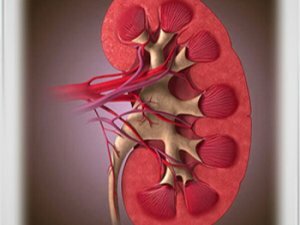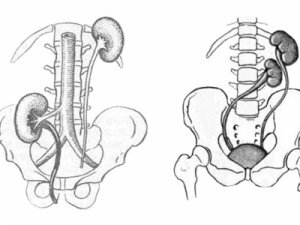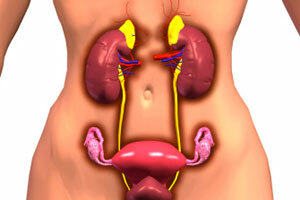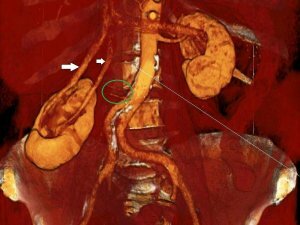Dystopia of the kidney

Description
Kidney Dystopia is a congenital pathology. Characterized by its incorrect location. The displaced kidney in the wrong position is fixed, losing its mobility. Among the anomalies, this pathology is most common. It is one-sided or two-sided. Usually one-sided dystopia is diagnosed. This is when one kidney has an incorrect localization in the body.
Depending on the location, the following types of kidney dystopia differ:
- Pelvic dystopia. In this case, there is a kidney between the uterus( in women) and the rectum, the bladder( in men).The ureter is shortened, the blood vessels from the internal iliac artery are spaced.
- Lumbar dystopia. This congenital disease occurs more often than others. Dystopic kidney is located just below the normal position. The organ in this situation is also twisted around its axis( forward pelvis).Dystrophy of the right kidney predominantly develops.
- Chiropody Dystopia. This type of kidney pathology is often mistaken for a cyst, as well as malignant formation in the abdominal region. This is because the kidney, being in the ileum, is easily palpable. Thoracic( subdiaphragmatic). The pathology form is very unusual. The ureter and blood vessels noticeably elongate. The kidney lies high in the chest region. Its appearance raises suspicion of a lung tumor, mediastinum cyst or pleurisy.
Reasons for
 Kidney dystopia is an exclusively genetic abnormality. The appearance and development of the disease generally does not depend on the method of delivery or qualification of the obstetrician.
Kidney dystopia is an exclusively genetic abnormality. The appearance and development of the disease generally does not depend on the method of delivery or qualification of the obstetrician.
To the development of kidney fetal dystopia can result:
- drinking alcohol and smoking;
- toxic effect of food;
- household chemical products;
- , the presence of such a disease with the next of kin;
- psychological trauma, mother's stress during pregnancy.
Not the last role is assigned to the development of disease and heredity. There are many cases of transmission of the disease to the child from the mother by genetic means.
Symptoms of
 Symptoms with a dystopic kidney depend on the location of this organ. Sometimes they do not appear at all, a person does not expect an anomaly.
Symptoms with a dystopic kidney depend on the location of this organ. Sometimes they do not appear at all, a person does not expect an anomaly.
Lumbar dystopia occurs without significant clinical signs. There may be mild pain in the lumbar region.
The ileum variant suggests symptoms due to pressure on the surrounding organs, nerve endings and vessels of the dystopic kidney.
It can be:
- pain in the stomach or abdomen;
- nausea and vomiting;
- violation of urinary outflow;
- violation of intestinal motility, constipation.
Pelvic dystopia causes severe symptoms in women on critical days and is accompanied by:
- with acute pain in the rectum;
- by painful urination;
- pain in the appendages, during menstruation;
- constipation( more often with a right kidney dystopia).
With dystopia of the left kidney, symptoms of pelvic organs can be simulated. It is often confused with inflammation of the appendages, ovarian cyst.
This kind of dystopia is not a contraindication to pregnancy. But the period of pregnancy and the process of delivery is complicated.
Thoracic dystopia causes pain in the chest area, causes shortness of breath. Often combined pathology with diaphragmatic hernia.
Diagnosis
A special place in the detection of the disease is differential diagnosis. It is important to distinguish different types of this pathology from the following diseases:
- iliac - a neoplasm in the abdominal cavity, ovarian cyst;
- lumbar - tumors, nephroptosis;
- pelvic - inflammation of the ovaries, ectopic pregnancy, tumors of the pelvic organs;
- thoracic - tumors and cysts in the chest, ulcerated pleurisy, abscesses( purulent inflammation).
For the diagnosis, the doctor conducts palpation. In the lumbar and iliac localization, the organ is probed through the abdominal wall. The pelvic gynecological examination is required.
Assign instrumental studies:
- angiography;
- ultrasound of internal organs and MRI;
- radioisotope renography and scintigraphy;
- Fluorography;
- ascending and descending urography.
Treatment of
 Treatment of kidney dystopia is predominantly conservative. The goal is the prevention of the development of the disease and the therapy of complications. The choice of a method of treatment depends not on the localization of the organ, but on its condition.
Treatment of kidney dystopia is predominantly conservative. The goal is the prevention of the development of the disease and the therapy of complications. The choice of a method of treatment depends not on the localization of the organ, but on its condition.
Reception of antibiotics and drugs to improve blood flow in the kidney is prescribed to patients with the development of pyelonephritis. With an intense pain syndrome resort to pain medications.
Surgical intervention is allowed only in the case of kidney stones, the development of nephroptosis and some other pathologies.
Surgery suggests:
- puncture the cyst of the organ;
- plastic of the ureteropelvic part;
- stenting of the arteries of the kidneys and angioplasty;
- nephrectomy.
Surgical treatment by moving a dystopic organ to its usual position is very difficult. Often, it is impossible to implement it. The problem is the difficulty of blood circulation for a given abnormality and a small diameter of the vessels.
Folk remedies
It is unacceptable to use folk remedies for kidney dystopia. Even with the help of modern diagnostic equipment, it is not always possible to put an accurate diagnosis. And about the people's doctors and not worth talking about. Often an inflammation of a displaced organ is taken for another disease, the cause is not clear. Treatment according to folk recipes only worsens the condition of the patient.
Complications of
There are several groups of complications of kidney dystopia.
Particularly serious complications occur during pregnancy:
- severe pain in the pelvis;
- probability of postpartum mortality;
- is a powerful toxicosis.
The complication of pregnancy and childbirth is the pelvic dystopia of the kidney. The enlarged uterus considerably displaces the dystopic kidney. The fruit changes its position to the transverse position.
Negatively affects the dystopic kidney on other organs. Under her pressure, there are veins and arteries, nervous clutches. May the mobility and sensitivity of body parts worsen, as well as trophic changes: dryness of the skin, hair loss, peeling.
In addition, the kidney itself suffers. When the vascular pedicle is bent, the organ may necrosis. The kidney is removed completely.
Prevention
Preventive measures should be performed long before the birth of the child:
- It is necessary to undergo a medical genetic examination to exclude the kidney anomaly.
- Abandon addictions.
- Rationally eat.
- Avoid infectious diseases.
- Avoid exposure to radiation and chemical agents.
- During the first year, carefully examine the child.
Patients with a dystopic kidney should always be supervised by a nephrologist or urologist.



